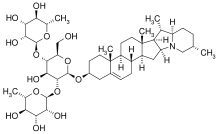 | |
| Names | |
|---|---|
| IUPAC name beta-D-Glucopyranoside, (3beta)-solanid-5-en-3-yl O-6-deoxy-alpha-L-mannopyranosyl-(1-2)-O-(6-deoxy-alpha-L-mannopyranosyl-(1-4))- | |
| Identifiers | |
3D model (JSmol) | |
| 77396 | |
| ChemSpider | |
| ECHA InfoCard | 100.161.828 |
PubChem CID | |
| UNII | |
InChI
| |
SMILES
| |
| Properties | |
Chemical formula | C45H73NO14 |
| Molar mass | 852.072 g·mol−1 |
| Melting point | 243 °C (469 °F; 516 K) |
Except where otherwise noted, data are given for materials in their standard state (at 25 °C [77 °F], 100 kPa). | |
α-Chaconine is a steroidal glycoalkaloid that occurs in plants of the family Solanaceae. It is a natural toxicant produced in green potatoes and gives the potato a bitter taste.[1] Tubers produce this glycoalkaloid in response to stress, providing the plant with insecticidal and fungicidal properties.[1] It belongs to the chemical family of saponins. Since it causes physiological effects on individual organism, chaconine is considered to be defensive allelochemical.[2] Solanine is the substance that have similar property as chaconine.
Symptoms
Similar to symptoms for ingesting solanine. There are a wide variety of symptoms include followings: Abdominal pain, diarrhea, headache etc.[3]
Difference between Chaconine and Solanine
Structural difference
Although α-chaconine and α-solanine are both derived from solanidine, its difference appears in 3 groups attached to the terminal oxygen in solanidine. For α-chaconine, those groups are D-glucose and two L-rhamnose whereas in α-solanine, those are D-galactose, D-glucose, and L-rhamnose.
Difference in Toxicity
In the experiment that demonstrate feeding-inhibition effect of solanine and chaconine using snail, chaconine had more effect than solanine. However, a mixture of chacponine and solanine had synergistic effect on snail. The mixture had significantly higher effect of deterred feeding than singly using solanine and chaconine.[4]
Ratio of ɑ-chaconine to ɑ-solanine in potato
In average, it is in a range of 1.2 to 2.6, meaning the amount of ɑ-chaconine is more than ɑ-solanine.[5] However, the average ratio of peel was 2.0 whereas the average ratio for flesh was nearly 1.5. Also, the ratio was not consistent and different by cultivar, growth condition, and ways to storage.[5][3]
Research about Glycoalkaloid
Controlling Amount of Steroidal Glycoalkaloids in Potato
In 2014, the research group in Japan, from Institute of Physical and Chemical Research (or RIKEN) found the genes for enzymes that are related to the synthesis of cholesterol, cycloartanol, and related steroidal glycoalkaloids(SGAs), SSR2. Since SGAs are biosynthesized from cholesterol, restricting those enzymes could reduce the amount of the SGAs in potato.[6]
See also
- Solamargine
- Solanine
References
- ^ a b Kuiper-Goodman, T. and Nawrot, P.S. "Toxin profile:Solanine and Chaconine" IPCS, INCHEM
- ^ Saponins used in traditional and modern medicine. Boston, MA: Springer. 1996. pp. 277–295. ISBN 978-1-4899-1369-2.
- ^ a b McKenzie, Marian; Corrigan, Virginia (1 January 2016). "Chapter 12 - Potato Flavor". Advances in Potato Chemistry and Technology (Second Edition): 339–368. doi:10.1016/B978-0-12-800002-1.00012-1.
- ^ Smith, David B.; Roddick, James G.; Jones, J.Leighton (May 2001). "Synergism between the potato glycoalkaloids α-chaconine and α-solanine in inhibition of snail feeding". Phytochemistry. 57 (2): 229–234. doi:10.1016/S0031-9422(01)00034-6.
- ^ a b Friedman, Mendel; Levin, Carol E. (2009). "Analysis and Biological Activities of Potato Glycoalkaloids, Calystegine Alkaloids, Phenolic Compounds, and Anthocyanins". Advances in Potato Chemistry and Technology: 127–161. doi:10.1016/B978-0-12-374349-7.00006-4.
- ^ Sawai, S.; Ohyama, K.; Yasumoto, S.; Seki, H.; Sakuma, T.; Yamamoto, T.; Takebayashi, Y.; Kojima, M.; Sakakibara, H.; Aoki, T.; Muranaka, T.; Saito, K.; Umemoto, N. (1 September 2014). "Sterol Side Chain Reductase 2 Is a Key Enzyme in the Biosynthesis of Cholesterol, the Common Precursor of Toxic Steroidal Glycoalkaloids in Potato". The Plant Cell. 26 (9): 3763–3774. doi:10.1105/tpc.114.130096.